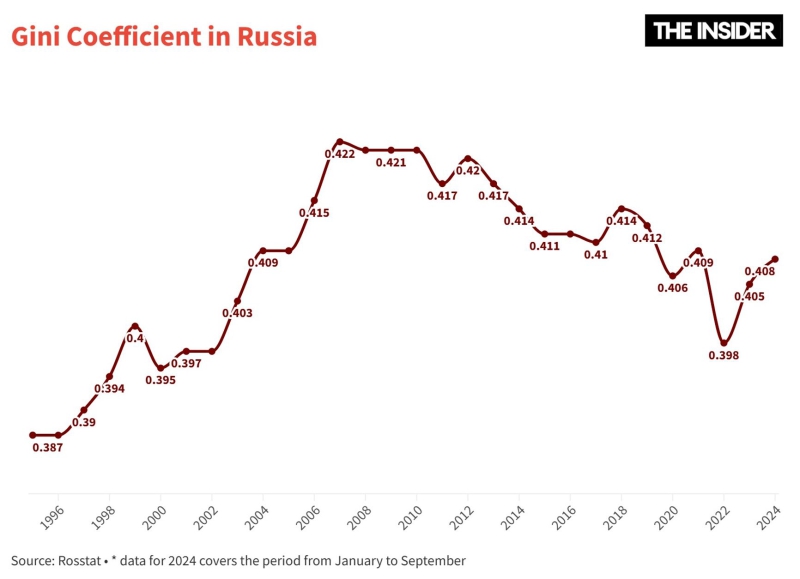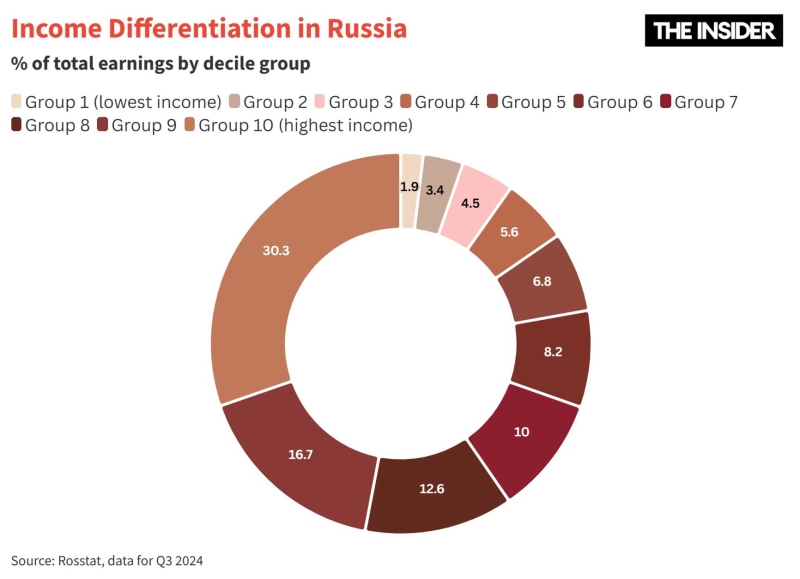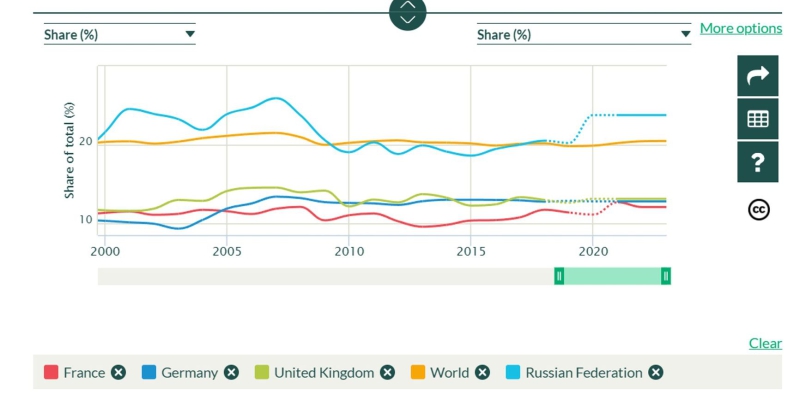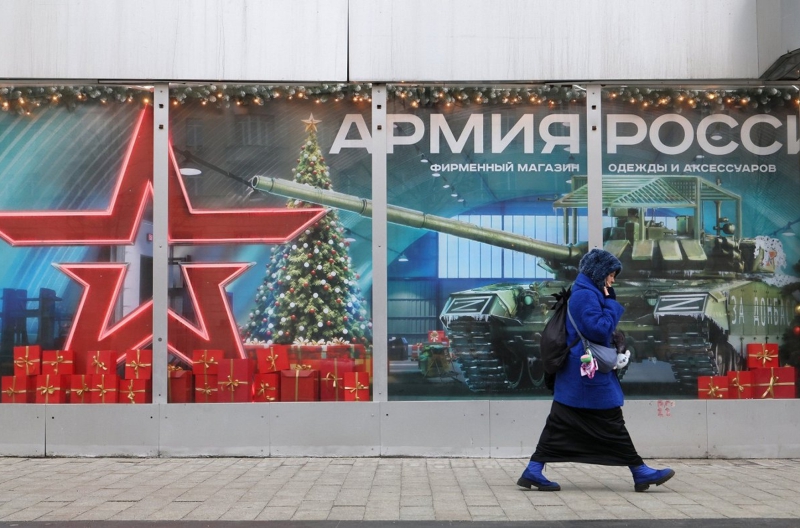Statistics confirm that Russia’s war economy has had a different impact on the poor and the rich. While the poor suffer from debt overload as skyrocketing prices outpace their social benefits, Putin-friendly oligarchs have inflated their income thanks to government contracts and the redistribution of property, while “ordinary millionaires” with sizable savings are profiting from high interest rates. As a result, the income gap in Russian society is rapidly widening, exacerbating social tension.
Russian officials hail the nominal rise in wages that began during Moscow’s full-scale invasion of Ukraine as a great achievement — even though the real causes are labor shortages and a wage race taking place in an overheated market. While Rosstat data for the third quarter of 2024 claim that average incomes grew by 18% in nominal terms — or by 8% after official inflation is subtracted — income growth is in fact a bidirectional process: the rich are getting richer, and the poor are getting poorer.
Even government data suggests that the gap between rich and poor Russians is growing, with the incomes of Russia's richest 10% growing twice as fast as those of the poorest 10%. In reality, the schism is even greater. First, the wealthy often avoid surveys and understate their actual earnings in reports to agencies. For real figures, researchers from the Center for Economic Measurements and Statistics of the National Research University Higher School of Economics turned to the Federal Tax Service, where they learned that the earned income of the richest 1% of Russians is 1.5 times what Rosstat data suggests. Second, inflation hits the population disproportionately, mostly affecting the poor, who spend most of their income on food and utilities. The weak growth in expenditures registered by Rosstat (6.6%) indicates that the poor have become even poorer, pointing to lower affordability of material goods.

There is a common misconception that the government's military spending helps the poor. In reality, it is more likely to benefit the rich. Within the military-industrial complex, salary growth has further increased the income of higher-earning groups, explains Elena Gorina, senior researcher at the Institute for Social Policy at Moscow’s Higher School of Economics. Presently, the incomes of the richest Russians have exceeded pre-war levels.
Early in the full-scale war, sanctions hit the richest while the poorest were supported by benefits, but later the rise in inequality returned
People can feel the effects themselves. According to survey data, Russians’ perceive the country’s current gap in living standards and opportunities as being worse than in the 1990s — or even in the era of serfdom. More than half (53%) of respondents note that inequality has intensified over the past five years.

According to the World Inequality Database, even before the full-scale invasion, the top 1% of Russia's population received about a quarter of all revenues — against 12-13% in Europe. Today the share of income received by Russia's richest minority is even higher.

The accelerated growth of already high incomes stems from the structure of their sources: salaries, business profits, and investments. The wage race favors wealthier Russians, as it affects primarily high-qualified professionals. In addition, wealthier households are more likely to save than to borrow. As a result, they have benefited from the surge in the Central Bank’s key interest rate, which in turn boosted deposit rates in commercial banks.
The surge in the Central Bank's key rate has benefited the rich while hitting the poor
Meanwhile, the most disadvantaged families receive their income mainly in the form of welfare benefits. In 2024, the growth rates of such transfers lagged behind inflation. In the third quarter of the year, the average pension amounted to 21,000 rubles ($237), which is only 7.6% higher than a year earlier, while the official inflation rate approached 9%.
Russian billionaires have been among the biggest beneficiaries of the economic turmoil caused by the war, experts at the London School of Economics point out. According to Forbes, the combined fortune of Russian billionaires has grown from $505 billion to $577 billion in 2024, exceeding the sum of all individual deposits held in Russian banks (53 trillion rubles, or about $545 billion).
The withdrawal of foreign companies from the Russian market created opportunities for businesses close to the government. Western firms such as McDonald's, IKEA, and BP were forced to sell their assets at deep discounts, effectively ceding them to Kremlin-loyal entrepreneurs. Foreign stakes in the energy and metallurgical sectors are also coming under the control of Russian players, further increasing the concentration of wealth in the hands of a government-affiliated clique.
McDonald's, IKEA, BP, and others were forced to sell their assets at deep discounts to Kremlin-loyal entrepreneurs
Owners and top managers of large companies catering to public sector clients are also the main beneficiaries of state defense contracts.
The growing wealth of the super-rich has been helped along by high commodity prices. Sanctions imposed on the Russian energy sector have reduced supplies to Europe, redirecting them to China and India. Although Russian oil is sold at a discount, relatively high global prices still translate into sky-high profits for large Russian companies and their owners. Russia's metal and fertilizer production also benefited from the global market turbulence caused by the war.
International sanctions have affected mainly middle-class and low-income Russians, who face higher prices for consumer goods, lower real income growth, and ultimately, a decreased standard of living. SMEs that are deprived of government support are under pressure due to rising costs and limited access to resources.
International sanctions have affected mainly middle-class and low-income Russians
Forced import substitution is beneficial to domestic manufacturers but not to the population as a whole. Automakers are replacing Western parts with domestic equivalents, and the agricultural sector is expanding production to compensate for declining food imports. However, the process is plagued by deteriorating product quality and reduced competitiveness. Russian goods do not always comply with international standards, which limits their export prospects.
The rapid growth of real wages, which the authorities are proud of, has already started to slow down. As the Center for Macroeconomic Analysis and Short-Term Forecasting (TsMAKP) notes, in the second quarter of 2024, they did not grow at all and only increased by 0.5% in the third quarter. Employee poaching is increasingly challenging for employers as the payroll burden on their revenues is “on a steady increase.”
At the same time, spending is also slowing down, with household consumption moving to stagnation in the third quarter. This past September saw a spike in non-food sales, but it had nothing to do with people in Russia having more money. Rather, large purchases were motivated by the anticipated hike in consumer loan rates and the impending car price hikes due to a planned increase in the utilization fee. As TsMAKP states, the September consumption surge was not sustained. Only food consumption is progressively increasing.
Consumer spending reached stagnation this past fall
The soaring wages of the early years of the war will leave a lasting impact on the economy. In a few years, job seekers in the labor market will have higher salary expectations formed during the boom, and many will feel entitled to a higher social status, TsMAKP predicts. But employers will probably not be able to meet those expectations due to higher job competition and the need to invest in equipment upgrades. Additionally, international competition may require cost reductions, including when it comes to labor costs, which will not permit the realization of expected wage growth rates.
Bridging the inequality gap requires extensive, targeted social support measures for the poor, as well as programs that stimulate wage growth in low-paying sectors of the economy. However, such initiatives in Russia are now being crushed by an overheated economy and accelerating inflation. Therefore, the problem of severe inequality is likely to persist.
Rising income disparities are widely believed to fuel tensions and may lead to a social crisis that can destabilize the entire state system. As many as 42% of Russians — mostly women, young people aged 18-24, residents of large cities, respondents with higher education, low-income Russians, and private sector employees — are struck by economic fears and concerned about growing inequality, a survey by the Institute of National Economic Forecasting of the Russian Academy of Sciences showed.
They believe that inflated government spending harms the material well-being of ordinary Russians, and they perceive inflation and staff shortages as signs of crisis. We can expect further polarization in Russian society between those who profited from the war and those who did not.

